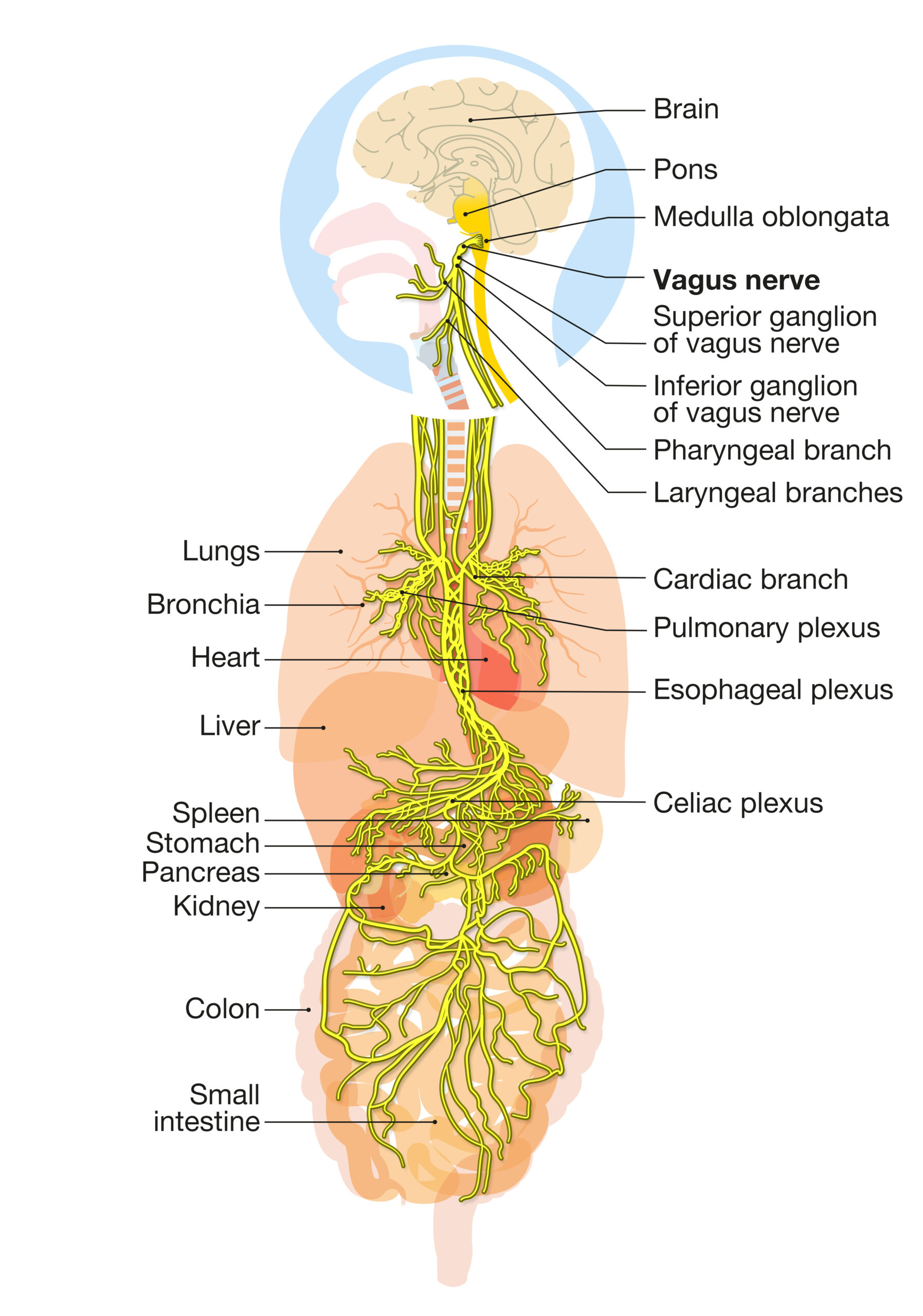How to Regulate Your Nervous System: The Role of Vagus Nerve Function
What You’ll Learn About Vagus Nerve Function
-
What the vagus nerve is and how it works as a communication superhighway between body and brain.
-
Why vagus nerve function is essential for stress recovery, energy regulation, focus, and emotional balance.
-
How impaired vagus nerve function affects performance, from fatigue and poor recovery to reduced resilience under pressure.
-
Practical ways to optimise your vagus nerve, including strengthening the organs it runs through, improving brain regulation with neurofeedback, and supporting recovery with IHHT and EMS training.
This post is part of a larger piece about nervous system training for stress and performance.
Click here for: The Complete Guide to Nervous System Training for Stress and Performance
Understanding Vagus Nerve Function
Maintaining a high level of performance, staying sharp and resilient, isn’t just about your mind; it’s inextricably linked to your vagus nerve function. The vagus nerve is the 10th cranial nerve, which is a core component of the parasympathetic nervous system.
Effective vagus nerve function allows your body to recover from stress, optimise energy, and maintain focus under pressure.
What Is the Vagus Nerve?
The vagus nerve is the longest nerve in the body, running from the base of the brain down through all major organs, including the heart, lungs, and gut.
How Vagus Nerve Function Regulates Stress and Recovery
Its proper function supports:
- Stress recovery and resilience
- Cognitive clarity, focus and decision making
- Emotional regulation under pressure
- Efficiency of breathing and oxygenation
- Optimised immune response and metabolic function
- Digestion and elimination
For anyone living a stressful lifestyle, too little parasympathetic recovery can mean difficulty switching off after work, reduced mental clarity, poor recovery from stress, disrupted sleep, and lower overall performance.

Why The Vagus Nerve Matters for Resilience
Stress Recovery and Nervous System Regulation
The vagus nerve is a communication superhighway linking body and brain, carrying critical signals that keep your vital bodily systems in sync. Most of this traffic flows upward from your organs to your brain, so your brain can monitor your body’s state and send instructions back down to adjust functions like heart rate, breathing, and immune activity.
Energy, Focus, and Cognitive Clarity
After high stress, an efficient vagus nerve enables a smooth shift from fight-or-flight into rest, repair, and recovery, which is vital for sustained performance. Acute stress can impair executive function, so good vagus nerve function allows the brain to recover and re-access clearer thinking after stress.
Emotional Regulation Under Pressure
Chronic stress, overwork, or unresolved adversity can impair vagus nerve function, making it harder to recover fully and maintain energy, focus, and resilience.
How the Vagus Nerve Supports Nervous System Regulation
Two-Way Communication Between Body and Brain
Maintaining performance in life and work doesn’t happen in isolation. The vagus nerve co-regulates with other cranial nerves that support social engagement skills, eye contact, facial expression, vocal tone, and the ability to read others’ cues.
Switching from Fight-or-Flight to Recovery
Strong social connection enhances recovery, emotional resilience, and overall performance, while stressful relationships can compromise vagus nerve function and slow recovery from stress.
What Happens When Vagus Nerve Function Is Impaired
When vagal signalling is disrupted, the nervous system struggles to reset after stress, leaving you stuck in hyperarousal or low-energy states. This undermines focus, decision-making, and resilience.
The Vagus Nerve and Social Engagement
Connection, Communication, and Leadership Presence
The vagus nerve is central to how we connect with others. It helps regulate facial expression, eye contact, vocal tone, and even subtle body language, signals that build trust and rapport. Strong vagal tone supports your ability to stay calm, listen deeply, and respond flexibly, which in turn shapes how others feel and perform. For leaders, recovery and vagus nerve function are also the foundation of authentic influence and collaborative performance.
How Relationships Shape Vagus Nerve Function
Our nervous system constantly “reads” the safety of social environments. Positive relationships marked by empathy, trust, and open communication strengthen vagal tone, speeding recovery from stress and reinforcing resilience. By contrast, conflict, chronic tension, or toxic dynamics can erode vagus nerve function, leaving you more reactive, less adaptable, and slower to recover. Over time, this undermines not only wellbeing but also the quality of your connections, teams, and leadership impact.
The Vagus Nerve and the Freeze Response
Beyond “Rest and Digest”, The Dorsal Vagal Branch
While the parasympathetic system is often seen as simply “rest and digest,” one component, the dorsal vagal branch, which is an evolutionarily older branch of the parasympathetic nervous system, is proposed to play a more complex role in how we respond to prolonged or extreme stress.
Why Understanding Freeze States Matters for Performance
Rather than calming us down, it can trigger a defensive, energy-conserving state experienced as withdrawal, emotional numbness, or low energy. Recognising this highlights that recovery and resilience aren’t just about winding down after stress; they involve navigating multiple layers of nervous system regulation.
This concept sets the stage for exploring Polyvagal Theory and its relevance to performance, where the nervous system balances activation, social engagement, and defensive strategies to optimise both performance and recovery.
Optimising Vagus Nerve Function for Resilience
Strengthening the Systems the Vagus Nerve Runs Through
Because the vagus nerve runs through nearly every major organ system, improving its function often means strengthening the health of the systems it connects. Supporting cardiovascular fitness, lung capacity and breathing efficiency, nutrition, hydration and gut health, and metabolic balance all enhance the quality of the signals travelling upward to the brain. The vaugus nerve is also impacted by the quality of our relationships, so making time for good social connections is a key aspect of leveraging knowledge of the vagus nerve for good recovery strategies.
Neurofeedback and Brain Regulation for Better Output
Just as importantly, optimising brain function improves the efficiency of the signals travelling back down into the body. This is where tools like neurofeedback can play a powerful role, helping the brain regulate more effectively so that vagal output supports calm, recovery, and balance across the whole body.
How IHHT and EMS Training Support Nervous System Regulation
Approaches such as IHHT for oxygen efficiency and EMS training for strength and mobility further reinforce vagus nerve function from both directions, top-down and bottom-up, in other words when we combine these approaches you improve communication and regulation both from body to brain and brain to body. This creates the foundation for recovery, resilience, mental acuity, and sustainable performance.
Key Takeaway: Vagus Nerve Function as a Resilience Advantage
The vagus nerve is more than a mechanism of recovery; it is a performance advantage. By supporting the health of organs it runs through, strengthening brain regulation, improving lifestyle and leveraging tools that improve the two-way communication between body and brain, you can enhance your capacity to recover quickly, regulate effectively under stress, and sustain high performance under pressure. It also strengthens the social dimension of resilience, helping you build trust, maintain composure in leadership, and foster stronger connections under pressure.
